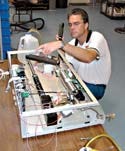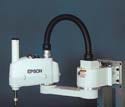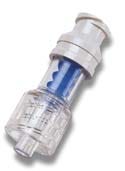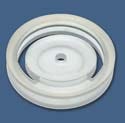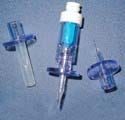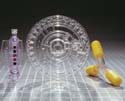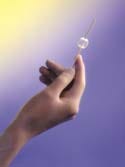September 10, 2003
Originally Published MPMN September 2003
REGIONAL FOCUS
A Climate of Innovation
Device OEMs and associated suppliers have made Southern California a medical technology hub
|
It has not been a good year for California, to put it lightly. A record budget deficit aggravated by legislative inertia and a governor running for his political life have taken some of the luster off the Golden State. But there are plenty of economic bright spots in the world's fifth largest economy, one of which is the healthcare industry.
California currently is home to more than 5500 registered medical device manufacturers. That represents a little more than 20% of the national total, according to figures compiled by the FDA Center for Devices and Radiological Health's Division of Small Manufacturers Assistance. Two of the state's three medical device manufacturing clusters are located in Southern California (the San Francisco Bay area is the state's third pole).
Not only is the device industry an economic force in the region, it is a font of innovation. Biomedical companies in Southern California invested more than $852 million developing new products for unmet medical needs in 2000, according to the California Healthcare Institute, an industry mouthpiece. On average, biomedical firms invest four times more in R&D than other high-tech companies, reports the institute. A facility opened by Siemens Hearing Instruments near Los Angeles to support an emerging technology, described below, is one example of a company building for the future.
The spirit of innovation thrives not only in Southern California's device industry, but also among the many suppliers of products and services that vie for its business. A small sampling of these firms are profiled in this section.
Siemens Finds a Place in the Sun
|
Siemens Hearing Instruments recently moved into a new 28,000-sq-ft facility near Los Angeles to meet growing demand for its products. |
Siemens Hearing Instruments has operated a production facility in Cerritos, near Los Angeles, for more than a decade. When the company needed to find a larger plant to accommodate its growing business needs, one of its top priorities was to source a facility in the immediate vicinity. "Employee retention was a key factor" in deciding where to look, says operations manager Dave Anderson. "Each of our digitally manufactured hearing aids is, in fact, a custom product. Fabricating them is more of an art form than a science," explains Anderson, and turning a technician into an artisan requires substantial training. Siemens did not want to risk losing its human resources by making an ill-considered relocation.
In January, the staff moved into a brand new facility in La Mirada, just three miles away from the old plant. The 28,000-sq-ft building was designed from the ground up to accommodate the company's unique laser manufacturing process and to meet future expansion needs. It is Siemens's largest satellite facility, serving the western United States, and the first to have been designed to integrate the company's proprietary manufacturing process.
The Laser Accurate Scan Replication (LasR) shell manufacturing process was introduced by Siemens at the 2001 American Academy of Audiology conference. The system's software combined with laser scanning and manufacturing technology produces highly accurate impressions of the ear canal, resulting in better-fitting hearing aids than can be obtained with conventional methods. "I do believe we are the first company to use this technology in a production environment," says Anderson. "Until now, it has been used mostly in R&D." Anderson credits the Southern California-based supplier of the production equipment for helping to "push the machines to the limit. It has been a good partnership," he adds. "The firm works very closely with us to make sure that everything happens when it needs to."
|
A quality inspection being done on catheters treated with the Lubrilast coating from AST Products. |
The LasR process uses laser scans of the ear canal to produce a "point cloud" 3-D image of the impression. The raw data are then used to create a surface over the virtual impression. Vent and receiver holes can be easily positioned, as needed. Guided by the 3-D rendered data, a laser sinters the polymer powder into a shell. Surface treatments texture the biocompatible material to resemble natural skin. Snug and securely fitting completely-in-the-canal, mini-canal, and half-shell hearing instruments can be made in this manner. Digital technology promises further advances, says Anderson, for which the La Mirada facility is already equipped.
Since the impression data are scanned and stored in a database, identical shells can be recreated on demand. "And in the not-very-distant future, doctors will be able to scan a patient's ear and send the information electronically to our production facility," says Anderson. "Physical impressions will become a thing of the past."
A Commitment to Safety
Like Siemens, Alaris Medical Systems is a medical device manufacturer. Unlike many OEMs, however, Alaris also supplies its technology on a contract basis to other device manufacturers.
To help eliminate needlestick injuries, Alaris has developed a needle-free valve and platform technology that can be adapted to a host of healthcare applications. The SmartSite Needle-Free system (described on page 43) is but one way in which the company advances the causes of innovation and safety in the medical device arena. The Alaris Center for Medication Safety and Clinical Improvement at the company's global headquarters in San Diego is also a key element in the firm's campaign to promote best practices for medication safety.
|
The Alaris Center for Medication |
Centerpieces of the sleekly designed suite are the simulated patient recovery and operating rooms. These fully equipped sites afford clinicians a hands-on opportunity to test various technologies and share best practices with colleagues in a simulated clinical setting. The center also includes mock nursing and pharmaceutical stations.
The Alaris center also hosts a number of events on the theme of medication safety. The use of technology to address administration errors was the subject of a roundtable discussion in 2002 that attracted leading national figures. More recently, the center convened a group of experts to discuss the use of bar coding to improve patient safety at the point of care.
Medication errors are a leading cause of morbidity in hospitals, noted Alaris OEM sales manager Bob Tolliver during an interview with MPMN. Case studies and statistics presented at the meeting made a compelling case for the use of bar coding to combat this trend. According to one participant, the use of bar coding led to a projected 87% annual reduction in medication errors in a single unit. Referencing the vaunted supply chain management of the world's number-one retailer, Tolliver asked, "If Wal-Mart can do it, why can't hospitals?"
The Alaris center also offers an array of consulting, evaluation, and training services for healthcare professionals. Nurses, in particular, may benefit from the NurseSmart program. Sophisticated analytical tools such as failure mode and effects analysis, as well as continuous quality improvement concepts, can be applied to nursing practices by trained Alaris Medical Systems staff.
Several other Southern California- based suppliers are featured in the following pages. From a firm that has issued a manifesto of scientific molding principles to a company that has developed an accelerator-free curing process to neutralize the presence of allergens in latex, they all share a firm commitment to providing device OEMs with creative solutions for their products and manufacturing needs.
Regional Focus Products & Services
Metal Fabrication Services
Precision machining of parts measuring 0.20 to 1.250 in. diam is offered by a company that recently moved into a new facility. "The move has positioned us to better accommodate the evolving needs of our clients," says Mark Deischter of Micro Precision Swiss. By optimizing its in-house capabilities, the firm can now satisfy customer requests for the full-service manufacture of components and assemblies, he adds.
The new facility houses an array of seven-axis CNC grinders, laser welding and marking equipment, and electrochemical marking systems. Stainless steel, titanium, PEEK, and Ultem are among the materials processed. The company has begun to explore processing platinum, as well.
An electronic MRP system ensures traceability of the materials and components throughout the production process. The company is certified to ISO 9002, EN 46002, and AS 9100.
Micro Precision Swiss
30331 Esperanza, Rancho Santa Margarita, CA 92688
Automation Equipment
|
Flawless product assembly performed in a compliant, validated manner is a necessity in the medical device sector. "Absolute quality is a huge driver in this industry," says Erik Poulsen, general manager at Ismeca USA Inc. That quest, he adds, is leading many device OEMs to Ismeca's door.
Headquartered in Switzerland, Ismeca has broad experience developing automation systems for the medical device, electronics, and semiconductor industries. One of the company's key strengths, according to Poulsen, is its ability to design systems that fully comply with the device industry's regulatory requirements. "We support the process with [extensive] documentation," he says, "That's part of our added value." Inspection and test systems, HEPA filters, and other accessories are routinely built into the systems to satisfy customer requirements, he notes.
Having full development and production facilities in the United States and Europe has been a boon to customers with multiple sites, adds Poulsen. Systems can be built in parallel in compliance with U.S. and EU regulations for companies with production facilities on both continents.
Ismeca offers a number of automation technologies that range from a single continuous process to individual cells to processes linked via synchronous or asynchronous methods. Production flexibility and the availability of modular plug-and-play configurations are among the most popular features of the automation systems.
The firm has developed units for the automated assembly of insulin pens, safety syringes, diagnostic kits, and a range of single-use devices.
Ismeca USA Inc.
2365 Oak Ridge Way, Vista, CA 92081
Digital Dispenser
|
A servo-driven automated dispensing system for precision processes has been introduced by a company that specializes in automated manufacturing solutions. The dispenser comes with powerful proprietary software and an easy-to-use graphical user interface that enables intuitive programming and control. The Champion 6809 can be configured to match exacting application requirements from dots to underfills with a placement accuracy within 3 µm, according to Creative Automation Co.
Designed for subnanoliter processes, the device dispenses dot diameters and bead widths down to 75 µm. Volumes can be less than 0.5 nl, and the positive-displacement pump can achieve up to 90,000 deposits per hour. Volumetric efficiency is ensured regardless of deposit size, viscosity, or temperature.
The unit comes standard with a three-axis brushless servomotor drive, x- and y-axis linear encoders, z-axis rotary encoder, Windows-style software, and an LCD. Numerous optional features are available.
Creative Automation Co.
11641 Pendleton St., Sun Valley, CA 91352
Machining Services
A job shop near San Diego manufactures Swiss-type machined parts from stainless steel, titanium, aluminum, alloys, and plastics for the medical device and dental industries. Jeropa Swiss Precision Inc. specializes in the production of miniature, complex components in small to medium runs, according to senior vice president Rosemarie Paroz. The company is registered with FDA as a contract manufacturer.
The facility is equipped with an array of 2-, 4-, 5-, and 8-axis CNC screw machines, as well as drilling, tapping, milling, turning, thread-rolling, reaming, honing, and broaching equipment for secondary operations. The turning capacity ranges from 0.015 to 11¼16 in. diam, with a maximum chucking diameter of 3.00 in. One of the more unusual pieces of equipment on the shop floor is the Skylab 20-24, a universal machine for secondary operations invented by company founder and president Jean-Louis Paroz.
A versatile machine that can drill, tap, mill, and slot, the Skylab 20-24 is where it all began for Jeropa, says Rosemarie Paroz. Her husband initially went into business selling the machine, until he realized that putting it to work on a contract basis would be more profitable. The company made a name for itself fabricating dental anchors; its reputation as a meticulous manufacturer of intricate small parts soon spread to other OEMs. Today, the medical and dental device industries represent 60% of the firm's business.
Jeropa Swiss Precision Inc.
950 Borra Pl., Escondido, CA 92029
Testing Equipment
|
Crescent Design hit the jackpot when it introduced its signature hydraulic burst and leak tester (HBLT) to the medical device market in 1994. Having a background in video poker and blackjack machines apparently helped.
In the early days, Crescent Design president Steve Royce and his partner Jay Sarno designed video machines for the gaming industry. Business declined after a while, "but that's really where our expertise in user interfaces comes from," says Royce. "You're dealing with people who may have had a bit to drink, so you have to make the interface as intuitive and obvious as you possibly can." Device OEMs presumably are a sober lot, but the HBLT's ease of use has been partly responsible for the product's success. The willingness of the Crescent Design team to listen to--and act on--customer requests has also been a significant factor.
"We started with a 1000-psi model," says Royce. "Pretty soon, someone called asking if we had a 1200 psi. We didn't, so we went to work on one." Currently, the company has five models available, with a sixth ready for rollout and a seventh in development. The company is putting considerable effort into adding peripherals that "empower users to do more with their testers," says Royce.
Other recent activities at Crescent Design include the development of software that will automatically time the deflation of a balloon inside a vein, an automated guidewire coiner, and a "smart" manifold that adds 10 outputs to the HBLT. Royce welcomes custom projects that test his firm's engineering mettle. "We build on what we've learned," he says, and the company's lean, nimble infrastructure enables it to solve customer problems in an effective manner. "Constant improvement and increasing our capabilities is how we compete," stresses Royce.
Crescent Design
9932 Mesa Rim Rd., Ste. B, San Diego, CA 92121
Robotics
|
"The medical device market is underserved by suppliers of robotic assembly equipment," says Michael Ferrara, director of factory automation robotics at Epson Robots. Naturally, his company is eager to fill that gap.
Epson Robots celebrates its 20th anniversary this year. Reaching that milestone is an indication of the firm's commitment to its customers and markets, and its ability to develop the products that people want. "There have been numerous boom-and-bust cycles in the past 20 years," notes Ferrara. "But Epson Robots was here when you woke up this morning and we will be here tomorrow." A single-minded focus on ease of use and flexibility has contributed greatly to the company's longevity, he adds.
The firm's EZ Modules, for example, can be configured by the user as 1-, 2-, 3-, or 4-axis robots. They come standard with a RC420 controller and user-friendly RC+ programming software; an RC520 controller is available for controlling multiple EZ Modules or a combination of modules and SCARA robots. ActiveX controls, conveyer tracking, Ethernet I/Os, force sensors, auditing systems, and vision guides can be easily integrated using the RC+ programming software.
The firm's robotic systems are typically used to package syringes, assemble biological test kits, load medical analyzers, test asthma inhalers, and dispense genetic materials.
Epson Robots
18300 Central Ave., Carson, CA 90746
Sterilization Systems
|
A just-in-time sterilization system is designed to use low-temperature hydrogen peroxide gas plasma to safely and rapidly sterilize most medical devices. Advanced Sterilization Products, a Johnson & Johnson Co., developed the Sterrad 200 GMP for industrial markets. The 7.3-cu-ft-capacity unit allows manufacturers of low-volume, high-cost products to "exercise control over their supply chain," says Mike Valentine, director, scientific and industrial business. "Sterrad allows you to deal with the process yourself. You're not at the mercy of a contract sterilizer who may tell you that you'll have to wait until he finishes another job." Control also allows a reduction of inventory. "Many companies today are metrics-driven, focused on just-in-time manufacturing and inventory reduction," says Valentine. "Using the Sterrad system, you can sterilize product on Monday and ship it Tuesday."
Although it may have been a concern in the past, process validation is no longer an issue, notes Valentine. "ISO 14937 sets out guidelines for sterility assurance levels of nontraditional methodologies, and FDA knows our products because they have 510(k) approval. I wouldn't have said this three or four years ago, but there is now a clear template and path to achieve regulatory approval using our sterilization process," stresses Valentine.
The company provides extensive validation assistance and regulatory and technical support to its customers. "We will test the product and packaging in-house. Within three days, we can tell a potential customer if we can sterilize the product," says Valentine. "Then we get to work on cycle development to match throughput expectations. That's redone on-site, and that all becomes part of the validation package. The instrument we provide is preprogrammed for plug-and-play operation," adds Valentine.
Advanced Sterilization Products
33 Technology Dr., Irvine, CA 92618
Needle-Free Valves
|
A study conducted in 1990 concluded that more than 800,000 hospital workers had a needlestick injury each year. Alarmingly, a significant number of those incidents involved exposure to HIV-contaminated blood. Needle-free valves developed by Alaris Medical Systems Inc. are among a generation of devices designed to help prevent those types of accidents.
The SmartSite needle-free valves feature a flush, swabbable top to minimize contamination. Made of latex-free materials, the valves have a straight fluid-path design similar to a standard injection port. Unlike competing products that may have as many as seven components, the SmartSite valves comprise only three parts. "Simplicity means repeatability," notes OEM sales manager Bob Tolliver. The streamlined design makes the valves cost-effective to manufacture, he adds. The technology has been recognized by the Medical Design Excellence Awards, an annual program organized by Canon Communications llc, which also publishes this magazine. In particular, jurors applauded the simple and reliable design and the innovative manner in which the product addresses safety concerns.
One of the strengths of Alaris, according to Tolliver, is its status as both an OEM supplier to medical device manufacturers and a direct supplier to hospitals. "Our logo goes on every product we make, regardless of whether it's for our use or produced for a client," says Tolliver. "We partner with our customers and stand firmly behind our products." The company has a vigorous quality control program, he adds. A fully automated system subjects each valve to 100% flow testing.
"SmartSite technology can be adapted to most IV administration applications," says Tolliver. Typical uses include infusion pump sets, heparin and saline locks, extension sets, vial access pins, vial adapters, and bag spikes.
The company also has substantial R&D resources available for product and process development. "Our focus is on high-volume, low-cost, high-quality disposables," says Janice McCampbell, director, engineering, disposable products. Concurrent engineering, a phased design and development process that allows for customization, and an emphasis on design for manufacture are among the department's procedures, she adds. Virtual engineering through the use of failure mode and effects analysis (FMEA) and other tools also plays a key role in product development. McCampbell cites a recent development project. "The device was designed with a single vent, which caused some stress issues. Using FMEA, we found that doubling the number of vents would solve the problem." That change saved the client a "huge amount in tooling costs. It's one example of what we can contribute by partnering with other OEMs," says McCampbell.
Alaris Medical Systems
10221 Wateridge Cir., San Diego, CA 92121-2772
Liquid Silicone Rubber Molding
|
A newly developed series of liquid silicone rubbers (LSRs) feature rapid cure rates and 5 to 8% compression sets after 4 hours at 200°C. The resistance to deformation is described as a boon to designers of medical parts such as seals, diaphragm pumps, valves, and catheters, according to Hi-Tech Rubber Inc. The firm's medical device tech team developed the LSRs in collaboration with material processors.
The contract molding company reports that the LSR products are available in a hardness range of 23 Shore A to 60 durometer and with a tensile strength of 1233-1421 psi. Elongation varies from 460 to 750%, depending on the LSR's durometer. The materials can be processed using a variety of molding applications. Cycle times can be shortened by molding using an automatic cold-runner technology.
Hi-Tech Rubber offers multiple processes and materials suited for the manufacture of elastomeric components used in medical devices. Prototype to high-volume production quantities can be accommodated.
Hi-Tech Rubber Inc.
3191 E. La Palma Ave., Anaheim, CA 92806
IV Components
|
Multipurpose vial adapters in three styles and sizes have been added to a company's product line. Latex-free and conforming with ISO 594, the KippMed vial adapter developed by Porex Medical Products Inc. enables a single adapter to be used with vials of varying sizes. Other features include a low insertion force and a design that allows maximum fluid withdrawal with minimal waste.
The adapter can be used with or without a needle-free access connector for multiple dosing. In addition, the device has the smallest fluid residual volume currently available, according to marketing manager Janice Tarwater.
The vial adapter joins the company's KippMed product line, which comprises proprietary medical products as well as standard IV luer connectors and caps. The firm specializes in the design and manufacture of precision complex plastic-injection tooling and custom molding of tight-tolerance medical devices. The ability to take a product from concept to prototype to full production, thus potentially reducing time to market, is described as one of the company's key strengths.
Porex Medical Products
930 Wanamaker Ave., Ontario, CA 91761
Molding Services
|
Scientific molding is not a new concept, Charles A. Brewer III readily admits. But C. Brewer Co. is really doing it, not just paying lip service, he stresses.
A third-generation mold maker and CEO of the firm since 1996, Brewer posits an understanding of the "four pillars" of the molding process as a prerequisite to achieving consistent success. By establishing fixed values for the four most important variables of the process--time, temperature, pressure, and cooling--the company can provide documented data to support the production of optimized tooling. "We see ourselves as a 911 service," says Brewer. "Customers routinely come to us with what might be characterized as a sick mold. We believe there is one optimal molding process, and it's our job to discern the problem and to fix it."
The company's forte is precision molding, specifically parts with tight tolerances that are used in the medical, biomedical, and electronics sectors. By combining mold making, molding, and assembly services under one roof, the firm offers customers the convenience of single sourcing. More than 40 Nissei machines ranging from 40 to 350 t are on-site, including all-electric machines in a Class 100,000 cleanroom.
To continue to meet and, indeed, exceed customer demands related to product quality and delivery times, the company maintains a large engineering staff and invests substantially in leading-edge technologies. Brewer cites the use of cavity-pressure-monitoring tools as one example. "A pressure transducer gets you close to exactly what's happening inside the cavity," he says. "It's one tool that we use to advance scientific process optimization." The next step in the company's evolution, he adds, is the introduction of a six-sigma molding process. "We have the tooling in place to achieve that," says Brewer. "It won't happen tomorrow, but it's coming."
C. Brewer Co.
3630 Miraloma Ave., Anaheim, CA 92806
Heat Sealing Equipment
|
Process control capabilities are among the priorities of medical device OEMs when they are sourcing equipment. As industry demands have evolved, so has the line of heat sealing equipment supplied by Belco Packaging Systems, notes Thomas A. Milisk, vice president, sales and marketing.
"We offer single- and dual-station tray sealers in four platen sizes at four levels of process control," says Milisk. Constant-heat bar and pouch sealers with two levels of process control capabilities are also available, he adds. The firm recently introduced tabletop tray and pouch sealers, configured for aseptic packaging. A unique feature of this equipment, according to Milisk, is that the machine itself can be sterilized by autoclave.
For tertiary packaging needs, the company supplies shrink packaging machines for form-fill-seal applications, infinite-length side sealers, automatic and semiautomatic L-bar sealers, shrink tunnels, and industrial blister sealers. The machines are available in a range of sizes and throughput capabilities.
Belco Packaging Systems
910 S. Mountain Ave., Monrovia, CA 91016
Dip Molding Services
|
A company that was founded in 1985 to develop dip-molded devices using advanced polymers in lieu of natural rubber latex provides a range of materials expertise to device OEMs. "We think of ourselves as an extension of our customer's R&D department," says Mark McGlothlin, president of Apex Medical Technologies. He adds that about half of the company's business currently involves materials consulting, licensing agreements, and related projects, with contract dip molding accounting for the rest.
The company's proprietary dip molding process uses synthetic elastomers to fabricate thin-walled components for the medical device industry. The firm has collaborated with many device OEMs from concept to final production to bring products such as catheter balloons, stent and probe covers, and tissue-removal sacks to market. Although polyurethane is the material of choice, a number of other thermoplastic elastomers have been used where high elongation values are desirable. For applications requiring low creep properties, synthetic polyisoprene latex has been processed.
"We developed synthetic polyisoprene latex to respond to customer requests for a material that acted like natural rubber," says McGlothlin. Dip-molded components made from this material have low modulus and tensile set properties, and high resiliency and ultimate elongation, he notes, but without the biocompatibility issues that plague natural latex rubber. "It does not contain proteins, thus preventing Type I allergies, and the absence of accelerators and nitrosamines virtually eliminates Type IV allergy concerns," says McGlothlin.
The company has recently adapted the curing process developed for synthetic polyisoprene latex to silicone. Dip-molded silicone latex products have the potential to compete with conventional liquid-injection-molded products, adds McGlothlin. Not only does the process achieve better material properties, according to McGlothlin, but the tooling costs are substantially lower.
Apex Medical Technologies Inc.
10064 Mesa Ridge Ct., Ste. 202,
San Diego, CA 92121
Copyright ©2003 Medical Product Manufacturing News
You May Also Like






